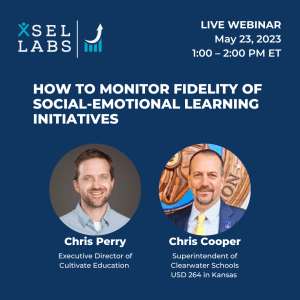Many SEL programs, when taught with sufficient quality and intensity, produce measurable improvements in student social, emotional, and academic outcomes. Those measurable benefits are summarized nicely in a meta-analysis of the impact of SEL programs on student outcomes.
Outside of research studies designed to measure program impact, however, there’s too little SEL assessment going on because (until recently) SEL assessments have been good for research but not practical for educators.
Strengthen SEL Programming with Assessment
Many of my colleagues in the education community who use one of the popular SEL programs tell me that the lack of available methods of assessing skill acquisition is a real limitation. They commonly want to know two things. First, at the beginning of the year, what are my students’ strengths and needs so I can use our preferred program to maximum benefit? They are looking for a formative assessment. Second, at the end of the year, have my students made progress? They are looking for an assessment that can monitor growth.
Without assessment, they can’t answer these questions.
Aligning SEL Assessment to Programming
The good news is that there are a growing number of SEL assessments that measure the skills commonly taught in evidence-based SEL programs. Our direct assessment, SELweb, for example, measures children’s understanding of others’ emotions and perspectives, their social problem-solving skill, and self-control. Sound familiar? These skills are commonly taught in the most popular SEL programs. To illustrate, this table shows the relationship between one program’s scope an sequence and what SELweb assesses.

Because SELweb is program-agnostic, and assesses dimensions of SEL in the CASEL model, it can be a strong companion to many programs.
In fact, most of our district partners adopted SELweb because they had started to use an evidence-based SEL program and they wanted an assessment that could help them plan instruction at the beginning of the year, and assess growth over the course of the year.
One of SELweb’s strengths is that it is a direct assessment—student demonstrate their skill by solving challenging problems, much as they do when they complete an achievement test. As I’ve written elsewhere, direct assessment is particularly suited to assessing social thinking skills—what goes on between the ears as children make sense of and respond to social situations. Other assessments such as Aperture’s DESSA are well-suited to assessing the behavioral dimensions of social-emotional learning. If schools can manage it, combining direct assessment with rating scales can provide complementary and very powerful information.
Benefits of SEL Assessment
We all want SEL programs to benefit students. Assessment can and should play a role in maximizing SEL program benefits. Assessing at the beginning of the year can help focus teaching so that it builds on students’ strengths and addresses their needs. Assessing at the end of the year can help determine how much progress students have made.
To learn more about SELweb, visit our website, or drop me an email at cmckown@xsel-labs.com.



